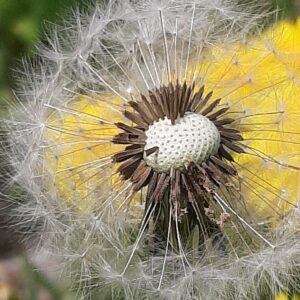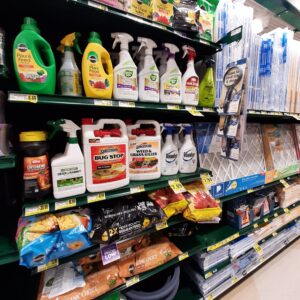
It’s a beautiful summer day. You’ve finished your stack of books from the Landis Book Barn and need something else for summer reading—maybe a thriller or a murder mystery. How about a best seller that involves poisons and deadly potions and is full of danger? If you want to read something that will really make your hair stand on end, try reading the label of a container of chemical herbicide.
It’s shorter than Harry Potter and the Deathly Hallows, but it’s certainly not dull reading. All sorts of words found in thrillers and horror stories leap out at you: “beware…killer… toxic...poison...danger...” Anyone, of any age, can buy lawn and garden pesticides off the shelf and use them at home without any sort of license, and therefore we tend to assume that these handy squirt bottles are trivial everyday stuff. As harmless as, say, dish detergent. Just to clean up those dandelions a trifle.

On every package, there is the number of a poison control center, or instructions to physicians, in case of accidental overexposure. Obviously, this is stuff you want to keep far away from a curious toddler. But what if you follow the directions and apply the pesticide precisely as instructed by the manufacturer? Pesticides are poisons. Pesticides kill things.
When lawn care companies put herbicide on a lawn, they are required by law to put up markers that warn of pesticide application, telling you to keep off the grass for twenty-four hours. But there are quite a few lawn users who can’t read those little signs.
We enjoy seeing chickadees hopping around on the grass, cardinals enjoying seeds at the feeder, robins pulling worms out of the earth. But we don’t see what happens after the birds fly away. Never noticed any dead birds on your lawn? Our knowledge of pesticides’ effects on birds is like a pyramid-shaped iceberg, of which the widest portion by far remains unseen. Only a few dead birds are noticed and collected; it’s probable that the vast majority of bird deaths caused by pesticides go undetected.
The sad irony is that dandelions—the main target of most herbicides—are absolutely great for birds. Dandelion flowers are of course an excellent source of nectar for honeybees, butterflies, and other pollinators, but birds? Dandelion seeds are full of nutrition, and small songbirds love them. It may sound weird, but those round gray seed-heads bobbing on the lawn are a lot of mini-birdfeeders. Goldfinches love dandelion seeds. I once watched a flock of goldfinches flitting from dandelion to dandelion, pecking out the seeds that thickly clustered on the end of the stem, leaving a trail of floating bits of fluff. Especially as summer is ending and the cold of autumn is drawing on, birds need the fats and protein found in seeds.
Dandelions are a non-native species, it’s true. But they’re not a major threat to woodland habitats because they’re not invasive. You may shake your head in disbelief at this statement, seeing how those determined yellow flowers invade lawns with the ruthless efficiency of tank battalions. But they don’t invade wilderness.
Dandelions flourish in sunny areas of disturbed soil and so stick to the areas dominated by humans: construction sites, parking lot edges, and their favorite habitat, lawns. They don’t head into the forest or venture onto the back-country trails. Dandelion seeds aren't adapted to hitchhike on the fur of a passing squirrel or raccoon -- they need wind. On the forest floor, there's little wind to disperse the seeds. And the sun-loving dandelion always perishes in the shade. So they’re no threat to Landis woodlands and forest wildflowers.
Reframing dandelions as bird feeders gives us one more reason to welcome them instead of exterminate them—and one more reason to avoid poisoning the lawn.
